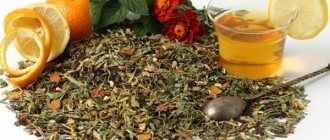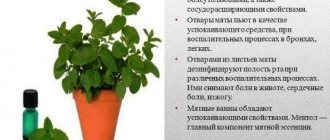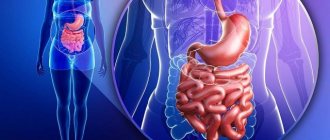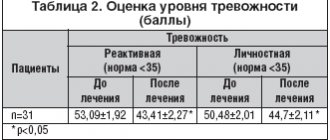Release form and composition
Dosage form - a herbal collection in the form of a crushed mixture or powder: raw materials from heterogeneous dark green particles with numerous inclusions of yellow, brown, orange, gray, white, with an aromatic odor; aqueous extract with a bitter-spicy, slightly cooling taste (crushed raw materials: 30 g, 35 g, 40 g, 50 g, 60 g, 70 g, 75 g or 100 g in a paper bag, 1 bag in a cardboard pack; 50 each g in a polypropylene bag, 1 packet in a cardboard pack; powder: 1.5 g or 2 g in a filter bag, 10 or 20 filter bags in a cardboard pack).
100 g of herbal collection contains:
- buckthorn (bark): 30 g;
- stinging nettle (leaves): 30 g;
- peppermint (leaves): 20 g;
- Calamus (rhizome): 10 g;
- Valerian officinalis (rhizome with roots): 10 g.
Pharmacological properties
Pharmacodynamics
According to the instructions, Gastric Collection No. 3 has antispasmodic, anti-inflammatory, choleretic, and laxative effects.
The effect of the drug is due to the combination of substances contained in five components of its composition:
- buckthorn bark: anthraglycosides, tannins, saponins;
- nettle leaves: mineral salts, carotene, vitamins C and K, tannins;
- peppermint leaves: menthol;
- rhizomes of calamus: essential oil, acorin, tannins;
- rhizomes with valerian roots: borneol, ester of isovaleric acid and borneol, free valeric and other organic acids, alkaloids (valerin, hatinin), sugars, tannins.
Medicinal mixtures are mixtures of several types of crushed, less often whole, plant materials. The composition of the collection includes various parts of plants: roots, bark, grass, leaves, flowers, fruits, seeds. Multicomponent medicinal herbal infusions have long been used in medical practice, which is explained by the effectiveness and gentleness of their action, the absence, as a rule, of unwanted side effects during long-term use, as well as the ease of preparation. Russia has a sufficient raw material base for many types of medicinal plants, experience in their production and clinical use. Medicinal herbal preparations are the most popular and widely used form of processing of medicinal plant materials.
Compositions from medicinal plant materials, sometimes with the addition of minerals, have been used in medicine all over the world since ancient times. Herbs are especially popular in oriental medicine: Chinese, Tibetan, etc. The recipes for these herbs are distinguished by the complexity of their composition, with a large number of components belonging to various morphological groups of raw materials. In Russian folk medicine, herbs were used less widely, since preference was given to individual medicinal plants.
Multicomponent mixtures from medicinal plant raw materials have valuable advantages over other herbal medicines: the ability to provide the main pharmacological effect in combination with a complex effect on the patient’s body as a whole, gentleness of action and the absence, as a rule, of undesirable side effects. They are quite simple to industrially produce and relatively cheap.
Treatment with multicomponent medicinal herbal mixtures is usually more effective than with single plants. When compiling the collection, it is necessary to take into account the individual characteristics of the patient and the presence of concomitant diseases. When choosing a collection, you need to know your blood pressure and take into account the main trend of its changes. For example, when choosing a collection for a patient with cholecystitis with arterial hypertension, it is necessary that the collection includes plants not only with a choleretic effect, but also with a hypotensive effect, otherwise the treatment may provoke a hypertensive crisis and worsen the general condition. In addition, one should take into account the tendency to constipation or diarrhea; Accordingly, the effect should be of a laxative or astringent nature. The effect of medicinal plant materials largely depends on the dose. Rhubarb root, for example, in large doses is used as a laxative, and in small doses, on the contrary, it has a strengthening effect. Various doses of spicy-bitter raw materials stimulate or inhibit the secretion of gastric juice. Some plants act on the muscles of the uterus and can be dangerous during pregnancy. Herbal infusions and remedies are not recommended to be taken during menstruation. Medicinal plant materials have a versatile effect. This explains the fact that in recipes with different purposes, the same components are often found, but in different quantities and different combinations. Only a doctor can foresee the unwanted side effects of medicinal plants after a comprehensive examination of the patient.
Depending on the types of raw materials included in the collection, infusions or decoctions are prepared on its basis. If the collection includes fragrant essential oil plants, then an infusion is usually prepared from them. Boiling is not allowed, since essential oils are volatile substances that evaporate along with water. Medicinal mixtures contain various biologically active compounds, which, simultaneously with the treatment of the underlying disease, additionally enrich the body with various vitamins, mineral compounds and other plant components that help increase the body's resistance, have a beneficial effect on the central nervous system, improve hematopoiesis, neutralize toxins and accelerate their removal from the body. body. In this case, the influence on physiological processes is carried out by natural, more acceptable organic substances for the body. Allergic complications when treated with medicinal herbal preparations are observed much less frequently than when using other medications (for example, of chemical origin). The versatile effects of plant biologically active substances often achieve their goals. Thus, when prescribing a complex collection for liver diseases, immortelle substances increase the secretion of bile, gastric and pancreatic juice, increase the tone of the gallbladder, and change the chemical composition of bile. Substances contained in corn silk have a beneficial effect on metabolism and improve bile secretion. Barberry substances reduce and relieve pain, which is due to the presence of the alkaloid berberine, which has an antispasmodic effect. For the same purpose, a peppermint leaf is often added to such a collection.
In addition to organic substances, the collections contain macro- and microelements that are involved in metabolism and are in functional interaction with enzymes, vitamins, hormones and other biologically active substances. Manganese, copper, zinc, cobalt in microdoses stimulate the production of antibodies and increase the body's resistance. Copper, iron, zinc, cobalt reduce the permeability of biological membranes. When treating a patient with multicomponent medicinal preparations, proteins, amino acids, carbohydrates, lipids, enzymes, vitamins, organic acids, alcohols, aldehydes and ketones, esters of phosphoric acid and other acids, phytosterols, resins and tannins, glycosides, terpenoids, coumarins are introduced into the body , amides and amines, betaines, choline and choline esters, purines and pyrimidines, alkaloids, bitter substances and many others.
The most popular medicinal herbal infusions are: antimicrobial, gastrointestinal, urological, thoracic, sedative, choleretic, antisclerotic, antispasmodic, carminative, diuretic, antiasthmatic.
Diseases of the gastrointestinal tract are quite widespread, accounting for 35–37% of the total morbidity of the population. The most common among them are gastritis, peptic ulcer, enterocolitis. Therapy for inflammatory and destructive diseases of the gastrointestinal tract is aimed at correcting disorders of gastric secretion, motor function of the stomach and intestines, intestinal digestion, and also involves influencing the altered mucous membrane of the stomach and intestines. The use of synthetic drugs does not always have the desired effect in this pathology; In addition, the development of adverse reactions and complications is possible. In such cases, as well as for the prevention of exacerbations of chronic diseases of the gastrointestinal tract, herbal preparations are very promising. The gastrointestinal collection is a combined preparation of plant origin, containing five types of herbal medicinal raw materials. The infusion of the collection has antispasmodic, anti-inflammatory, choleretic, sedative, and regenerative effects. The effect is determined by the essential oil, polysaccharides, and flavonoids contained in chamomile flowers; essential oil from mint leaves, the main components of which are menthol, flavonoids, vitamins; essential oil from dill fruits.
Inflammatory diseases of the bronchi are now widespread and are one of the most common causes of loss of performance. Antibiotic therapy used for their treatment often leads to the development of allergies, the formation of resistance of microorganisms with loss of sensitivity to antibiotics during subsequent courses of treatment, the development of dysbiosis and an increase in the number of fungal diseases. Experience in the clinical use of chest collection demonstrates its effectiveness and feasibility of use in infectious and inflammatory processes in the bronchi as an auxiliary or alternative medicine, free of unwanted side effects. The medicinal effect of the collection is due to the antibacterial effect of chamomile flowers, wild rosemary shoots, calendula flowers, the expectorant and enveloping effect of licorice roots, violet grass and wild rosemary shoots, the anti-inflammatory and antispasmodic effects of licorice roots, chamomile flowers, calendula and mint leaves.
Recently, there has been a significant increase in the prevalence of conditions caused by increased physical or mental stress, exposure to adverse environmental factors, growing information loads, and stress. In such conditions, chronic fatigue develops, which leads to the development of insomnia, increased nervous excitability, irritability, neurasthenia, cardiovascular neuroses, tachycardia, hysteria, migraine, vegetative-vascular dystonia, menopausal disorders, and arterial hypertension. There are a lot of medicinal plants that have a sedative effect. The sedative, antispasmodic, hypotensive effect of the sedative collection is due to the medicinal herbs included in it. The effect is determined by the essential oils, saponins, tannins, and alkaloids contained in motherwort herb; peppermint leaves contain menthol; in rhizomes with valerian roots - ester of borneol and isovaleric acid, free valeric and other organic acids, alkaloids (valerine and hatinin), tannins, sugars; licorice roots contain licurazide, triterpenes, glycyrrhizic acid and flavonoids; thyme herb contains essential oil, tannins and bitter substances; in oregano herb - thymol, flavonoids, tannins; in hop cones – essential oil, organic acids, alkaloids, flavonoids, lupulin; in the sweet clover herb - coumarins, melitoside, polysaccharides.
The preparation of infusions and decoctions from collections of medicinal plants is not fundamentally different from the preparation of these preparations from the raw materials of individual medicinal plants. Specific instructions for preparing infusions and decoctions from collections usually give the following ratio: 1–2 tablespoons of the mixture per 200 ml of water.
In all cases, to completely extract the active substances, much more water is taken than when preparing similar medicines in a pharmacy. Therefore, the prepared medicine is most often taken not with spoons, but in 1/3–1/2 cups. If the infusion or decoction is prepared daily, it is not subject to microbial contamination and can be stored at room temperature throughout the day. For larger quantities, it should be stored in the refrigerator, but no more than two days.
Usually, when treating with medicinal plants, improvement occurs within a few days, but a lasting effect can be achieved only with long-term and regular use of medicinal herbs. The absence of a positive effect within 2–3 weeks is usually grounds for replacing the collection. The course of treatment with the fees should be determined by the attending physician with constant monitoring of the patient’s health.
When treating chronic patients with plant herbs, they are taken for a long time. To avoid getting used to them and reducing the effectiveness of the therapeutic effect, it is recommended to take a break for 1-2 weeks after each course of treatment (1.0–1.5 months). For the same reasons, it is advisable, after 2-3 courses of treatment with one of the preparations, to switch to treatment with another, which has a similar effect.
Information about the authors: Samylina Irina Aleksandrovna – Doctor of Pharmaceutical Sciences, Professor, Corresponding Member of the Russian Academy of Medical Sciences, Director of the Research Institute of Pharmacy; Head of the Department of Pharmacognosy MMA named after. THEM. Sechenov. Tel.; Sorokina Alla Anatolyevna – Doctor of Pharmaceutical Sciences, Professor of the Department of Pharmacognosy of the MMA named after. THEM. Sechenov. Tel.; Pyatigorskaya Natalya Valerievna – candidate of pharmaceutical sciences, associate professor, deputy director of the Research Institute of Pharmacy for scientific work. Tel.
Instructions for use of Gastric Collection No. 3: method and dosage
The prepared infusion from plant materials is taken orally, 100 ml in the morning and evening.
Recommendations for preparing the infusion:
- crushed mixture: 1 tablespoon (approximately 5 g) of the mixture is placed in an enamel bowl, poured with 200 ml of hot boiled water, covered with a lid and infused for 30 minutes in a boiling water bath, then for another 10 minutes at room temperature. After straining and squeezing out the remaining raw materials, you should bring the volume of the resulting infusion to 200 ml by adding boiled water;
- powder: 2 filter bags are placed in an enamel or glass vessel, 200 ml of boiling water is poured in, covered with a lid and infused for 30 minutes (the contents of the vessel should be stirred periodically). By removing and squeezing the filter bag, the volume of the resulting infusion is brought to 200 ml with boiled water.
It is recommended to shake the infusion before taking.
Collection of gastrointestinal Fitogastrol N20 filter bags
Latin name
Phytogastrol
Active ingredient: Calamus rhizomes + Peppermint leaves + Chamomile flowers + Licorice roots + Dill fruits (Acori calami rhizomata + Menthae piperitae folia + Chamomillae recutitae flores + Glycyrrhizae radices + Anethi graveolentis fructus)
Compound
Each gram of the collection contains 200 mg of active ingredients: chamomile flowers, peppermint leaves, dill fruits, calamus rhizomes and licorice roots.
Release form
It is produced in the form of a herbal collection, which looks like small yellow-brown pieces of plant material interspersed with yellow, white, green or brown. Characterized by a strong aroma. The water extract is bittersweet.
The medicine is packaged in bags of 50 g or in small bags of 1.5 g. A bag of 50 g or 20 bags of 1.5 g is placed in a cardboard box.
Small bags contain plant raw materials, which are more crushed, almost to a powdery consistency.
pharmachologic effect
It is a herbal preparation that affects the digestive system. It has antispasmodic, anti-inflammatory, enveloping, choleretic effects and is able to correct the functioning of the gastric glands.
Pharmacodynamics and pharmacokinetics
Pharmacodynamics
The effect of Fitogastrol (gastrointestinal collection) on the human body is determined by the properties of the plants included in its composition:
peppermint leaves stimulate the secretion of gastric juice, increase the efficiency of the digestive process;
licorice root contains the substance glycerizin, which promotes the healing of ulcers and prevents their appearance;
chamomile flowers stimulate regeneration processes;
the fruits of dill contain a whole complex of biologically active substances (essential oil, flavonoids, carotene, phytoncides, sugars, vitamin C and others), which causes choleretic, antispasmodic, diuretic effects, helps cope with gas formation in the intestines, increases the secretory activity of the gastric glands;
a complex of biologically active substances contained in calamus rhizomes affects the endings of taste buds, causing an increase in appetite, improves the quality of the digestive process, enhances the reflex secretion of gastric juice, increases bile secretion, increases the tone of the gallbladder, and stimulates urination.
Pharmacokinetics
Not studied.
Indications for use
Gastric collection Fitogastrol is indicated for various diseases of the digestive tract, for example, colitis, gastritis, functional dyspepsia. Usually used in combination with other medications.
Contraindications
The use of Fitogastrol is contraindicated for:
hypersensitivity to one or more ingredients included in the collection;
calculous cholecystitis;
exacerbation of peptic ulcer of the stomach and duodenum;
treating patients under 12 years of age;
during pregnancy and lactation.
Side effects
Allergy symptoms may appear. In this case, you need to consult your doctor about how to take Fitogastrol in the future and whether it is worth doing.
Fitogastrol, instructions for use (Method and dosage)
A tablespoon of the collection is poured into an enamel or glass container, poured with a glass of boiling water, closed and kept in a boiling water bath for 15 minutes. Then cool for 45 minutes, filter and squeeze. Add water to the infusion so that its volume becomes 200 ml.
Place 2 bags in a glass or enamel bowl, add a glass of boiling water, leave for 15 minutes. Then the bags are squeezed out, and the volume of the solution is adjusted to 200 ml.
You need to drink half a glass half an hour before meals. The reception is repeated three times a day. The duration of the course of treatment is selected by the attending physician individually for each patient, as it depends on the nature of the disease.
Shake it well before drinking part of the solution. The prepared solution can only be stored in the refrigerator and for no longer than 2 days.
Overdose
There have been no reports of overdose.
Interaction
Not known.
Terms of sale
Over the counter.
Storage conditions
Must be stored in original packaging in a cool, dry place.
Best before date
2 years (dry collection), 2 days (prepared aqueous extract).
For children
Not used for treatment in patients under 12 years of age.
During pregnancy and lactation
It is not advisable to prescribe to pregnant and breastfeeding women, since clinical studies have not yet been conducted regarding the safety of the use of Fitogastrol for such categories of patients.




